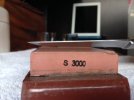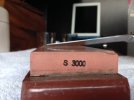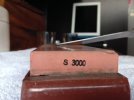I am having an aweful time trying to sharpen my spearpoint Strider MT. It's hollowground S30V, and seems very hard to sharpen compared to any other knife I've owned. I can get the straight portion, at the base of the blade, hair flinging sharp but I cannot seem to get the curved portion to sharpen. Factory spec's a 22.5 degree angle per side. I've been using Spyderco fine and ceramic flat stones and a leather strop with compound.
I'm considering just redoing it with my Sharpmaker at 20 degrees per side. Any reason not to?
I've never had an S30V fixed blade before, and I'm honestly afraid of the blade chipping if I thin it out too much. I was told that Strider heat treats their S30V differently and not to worry about it, should I?
Any basic sharpening advice for a spearpoint fixed blade, where the straight portion gets sharp easily, but not the curve?
I'm considering just redoing it with my Sharpmaker at 20 degrees per side. Any reason not to?
I've never had an S30V fixed blade before, and I'm honestly afraid of the blade chipping if I thin it out too much. I was told that Strider heat treats their S30V differently and not to worry about it, should I?
Any basic sharpening advice for a spearpoint fixed blade, where the straight portion gets sharp easily, but not the curve?












